Walkley award-winning Australian photojournalist David Dare Parker spent a month at the Rohingya refugee camps in Bangladesh near the Myanmar border, witnessing the unfolding humanitarian crisis, and documenting survivor stories.

Words and Photography
By David Dare Parker
December 22, 2017
Reading time: 15 minutes
This feature contains content that may be distressing.

A Rohingya elder stands gracefully with staff in hand, giving direction. Men row steadily, without so much as a glance in the direction of a small group of photographers wading out to greet them.
Women and children huddle together, quietly. The eight makeshift rafts, made of bamboo poles and yellow plastic palm oil containers, carry Rohingya refugees across the Naf River on a tide-dependent five-hour journey from Myanmar into Bangladesh.
This exodus from Rakhine state, Myanmar to the makeshift camps that have sprung up in Cox’s Bazar District, is a daily occurrence. Some arrive in the dark of night by fishing boat, where they wait, wet and shivering, on the beach until first light.
Others wade across the river at low tide at the Anjuman Para border crossing point.
So far more than 650,000 people have fled into Bangladesh, swelling the camps and creating a humanitarian crisis.
The exodus began August 25, 2017, when militants from the Arakan Rohingya Salvation Army targeted about 30 police posts and an army base, killing several people.
Myanmar’s security forces responded with a military campaign, which has been denounced by UN human rights chief Zeid Raad Al Hussein as a “textbook example of ethnic cleansing”.
The Rohingya refugees I spoke to in Balukhali refugee camp, one of several that have sprung up on near the Bangladesh-Myanmar border, told of the Burmese army destroying villages, raping and murdering Rohingya Muslims in Tula Toli (Min Gyi) village in Rakhine State on August 30, 2017.
Their stories were consistent with those told to Amnesty Internationaland Human Rights Watch: of soldiers shooting men and boys, women being beaten with sticks and raped, children thrown into the river to drown and huts set on fire - some with rape survivors locked inside.
The following accounts of the events of August 30 at Min Gyi were translated with the help of an interpreter.

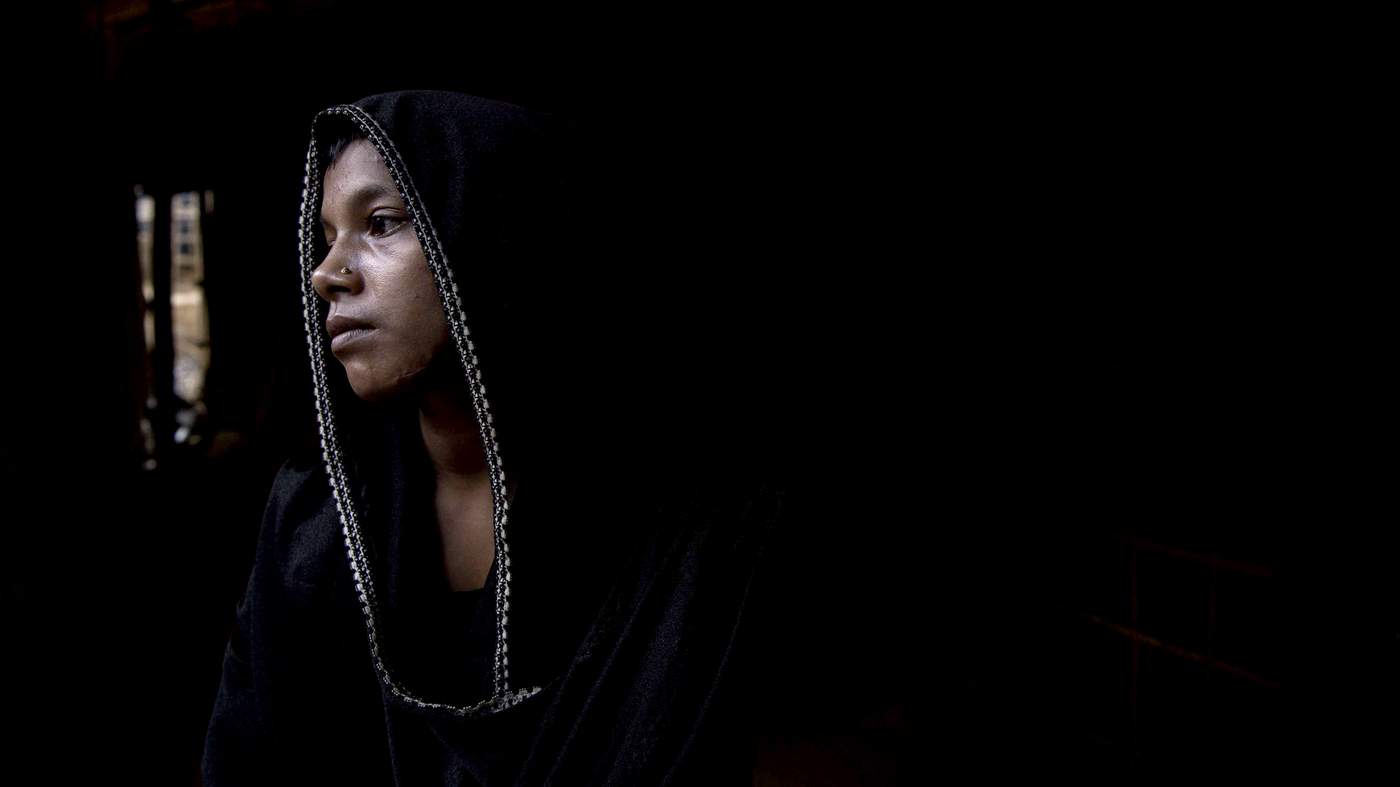
Rajuma Begum (20) told how the military killed her baby by throwing the little boy onto a fire.
Then she said she was raped, stabbed, and left for dead. Rajuma’s parents, two sisters and brother were also killed.


Hasina Begum (21) said she watched Myanmar soldiers kill her one-year-old daughter, Sohaifa, by throwing her on to a fire while the little girl was still alive.
Then Hasina and her sister-in-law Asma were dragged into a hut and raped.
The hut was set on fire with both women inside. Somehow escaping the fire, the women fled, making the three-day journey into Bangladesh.


Hasina Begum (21).


Roshida Begum (24) said her child was torn from her arms and thrown to the ground, then killed in front of her by soldiers. Then, brutally raped, her throat was cut and she was left for dead.


Roshida Begum (24).


Foruda Khatun (50) told of being stabbed near the eye and left for dead.


Dildar Begum (27) said she saw her husband and three children, two boys and a girl, killed by Myanmar soldiers. Dildar was then raped, attacked with a machete, and left for dead.
Her surviving daughter, 10-year-old Noor, witnessed everything. She was also struck in the head with a machete.

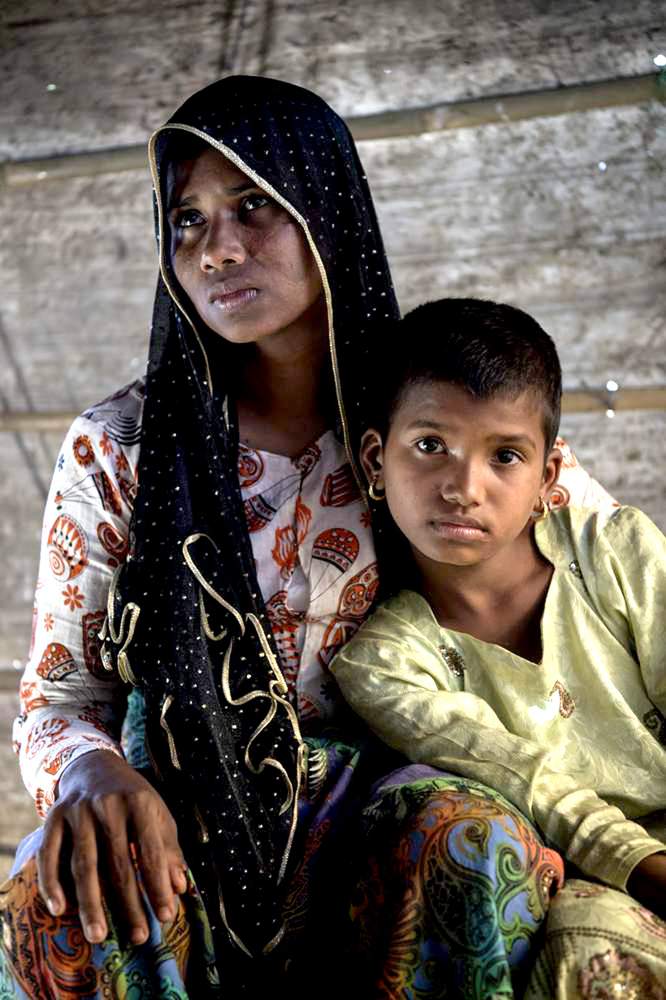
Dildar Begum (27).

10-year-old Noor.


I first photographed Momtaz Begum at the Balukhali food distribution centre, where she was sitting patiently, among hundreds of other refugees, waiting for her turn to receive a bag of rice, a fresh bandage covering up burn marks on her face. A week later I met Momtaz again, this time with her seven-year-old daughter Razia, in their makeshift bamboo and plastic tarpaulin shelter. She tells howBurmese soldiers killed her husband and three sons in front of her and raped her. She draws Razia close, and points out the scars where a soldier had struck repeatedly with a machete. Both mother and daughter were then locked inside a burning hut and left to die. Somehow they managed to escape.
Through our interpreter, Nayan, my fellow photojournalist Patrick Brown asks Momtaz if there is anything we can do to help. There is, so we head to nearby Kutupalong station and buy a small machete for cutting both fire wood and vegetables, and a second mat for the dirt floor of their makeshift hut. Apart from a small torch, there was no power or lighting in the shelter, so we add a couple of led lights, a solar panel and a rechargeable battery to the supplies. Momtaz and Razia now had light inside their hut, and Momtaz manages a smile. The resilience of these survivors is extraordinary.

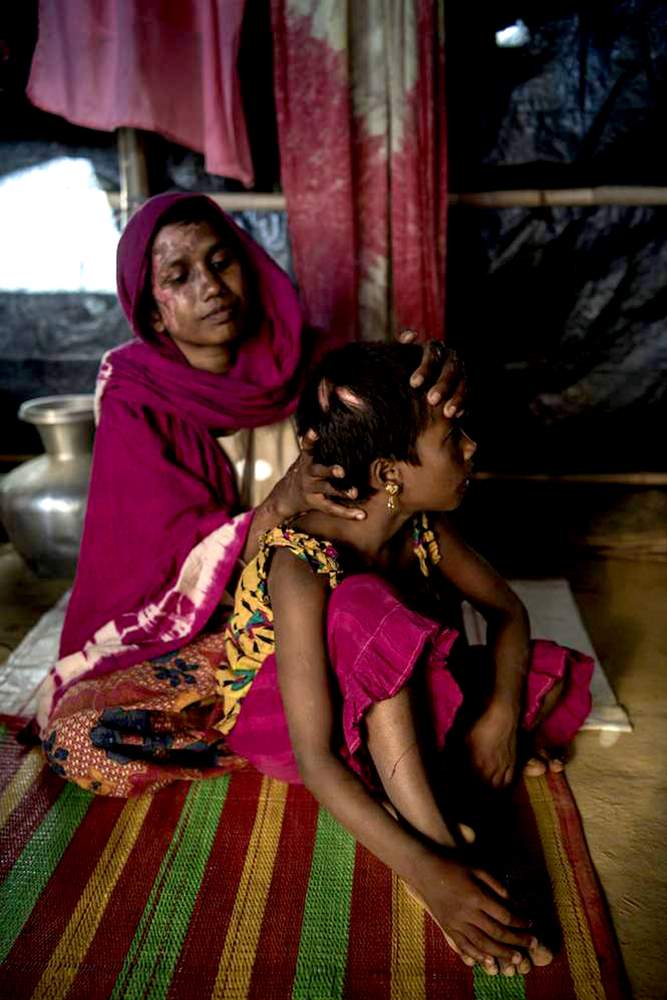
Momtaz Begum with her seven-year-old daughter Razia,
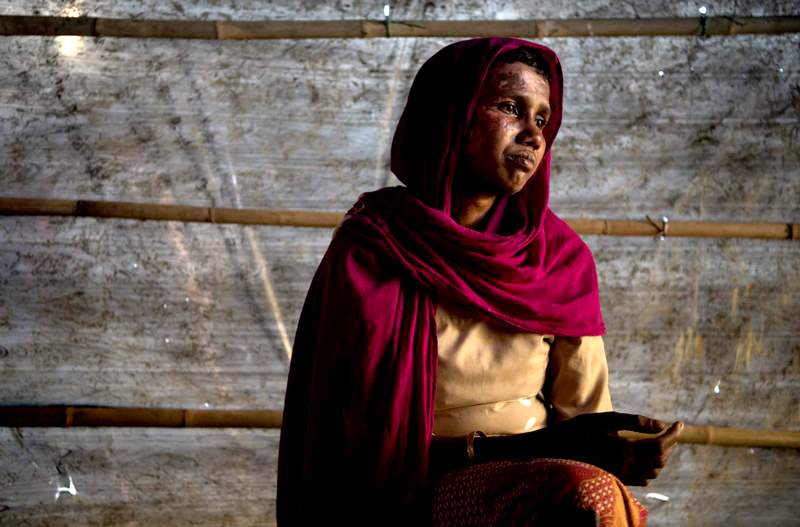
Momtaz Begum.


Min Gyi is not the only village where there have been reports of destruction. Human Rights Watch has “identified 40 villages with building destruction occurring in October and November, increasing the total to 354 villages that have been partially or completely destroyed since August 25, 2017”.
The humanitarian group Médecins Sans Frontières (MSF) on December 14 concluded that at least 6700 Rohingya were killed in the violence between August 25 and September 24, based on surveys of refugees in Bangladesh. More than 700 were children below the age of five.
The full picture of the violence is still emerging.

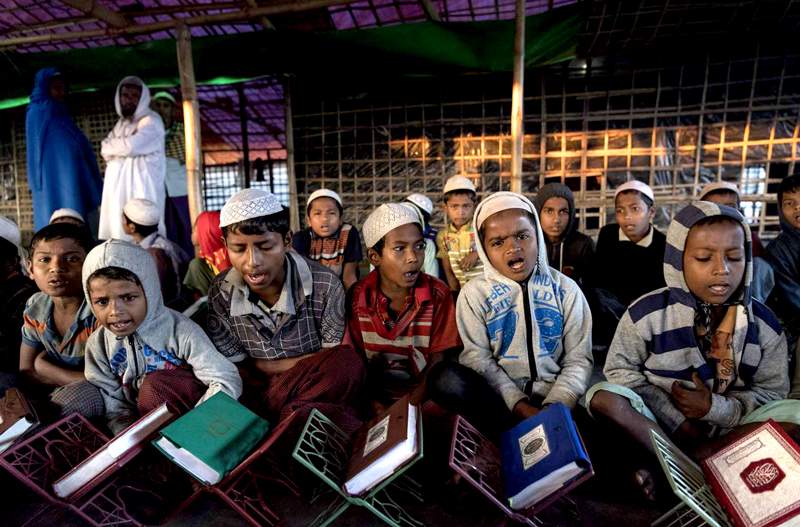
Rohingya children attend class at a madrassa within the Kutupalong refugee camp in Ukhia, Cox’s Bazar District, Bangladesh.

The Rohingya are Muslims who consider themselves native to the northern Arakan region of Myanmar. They believe they are descended from 7th century Arab, Mughal, and Bengali merchants who settled in Arakan territory, now referred to as Rakhine.
Myanmar considers the Rohingya to be illegal ‘Bengali’ immigrantsfrom Bangladesh, the result of British occupation bringing with it a wave of immigration into Arakan in the 19th century.
The Rohingya are not recognised within Myanmar as one of its 135 ethnic groups. The Rohingya have never been allowed citizenshipwithin Myanmar.
Extremists among Myanmar’s Buddhist Rakhine, including hard-line monks, have supported the military campaign. Repatriation ‘deals’between Myanmar and Bangladesh that have been recently discussed seem unlikely to succeed.


Young Rohingya refugees study at a mosque at the Kutupalong refugee camp,
Cox's Bazar, Bangladesh.



Daily life in the camps in the Cox's Bazar District is difficult. The newly-arrived refugees are unable to work, so they rely on handouts from the Bangladesh government, and humanitarian groups. They can spend hours at distribution points, waiting their turn for bags of rice and other aid.
To add to the misery of the overcrowded camps, poor sanitation, wells fouled by nearby latrines and malnutrition there is the fear of rapidly spreading diseases such as cholera, measles and a recent outbreak of diphtheria.



It is hard to imagine that three months before, Balukhali camp was a heavily-forested elephant sanctuary. Recently, elephants moving through their usual walkways panicked, trampling tents and killing a woman and her three children.
Standing at the top of this hill at the furthest edge of the camp are dusty mounds of tarpaulin and bamboo shelters, as far as the eye can see.



The children's spirits seem undimmed by the harsh reality of camp life. When they are not gathering firewood or fetching water from wells, they are kicking soccer balls, playing cricket and flying kites.


A Walkley Award-winning photojournalist, David Dare Parker has photographed
for many national and international magazines throughout Asia,
the Middle East, Europe and Australasia.

I went to Balukhali camp in Cox’s Bazar District, Bangladesh, in November-December 2017 as a freelance photojournalist. I found myself working with a small group of media, some working for traditional news outlets, others getting the message out for NGOs or humanitarian groups.
To a person, we all understood how important it was to play some part in trying to keep this story in the news. If our sources told us there was a refugee-loaded raft on its way into Bangladesh, we shared the information.
I am a photographer, however, in some ways, this story is all about words. Testimony.
Most of the survivors we met had told their stories before, to other media, and it was difficult to ask them to relive their horror again.
It was hard to imagine how such hatred could be directed towards the people sitting in front of us. These were simple villagers, not insurgents. Mothers, fathers, grandparents, husbands, wives and children: all of them survivors of the unimaginable.
The women had been through the worst of it. Their testimony of having their children killed in front of them. Gang rape. Throats cut, hacked with machetes – to be left for dead. But every person we met, that had a story to tell, wanted to tell it. Their stories were consistent. They want to be believed. They want the world to know what they have been through. They want justice.

To donate to the UN Rohingya Refugee Crisis appeal click here.


